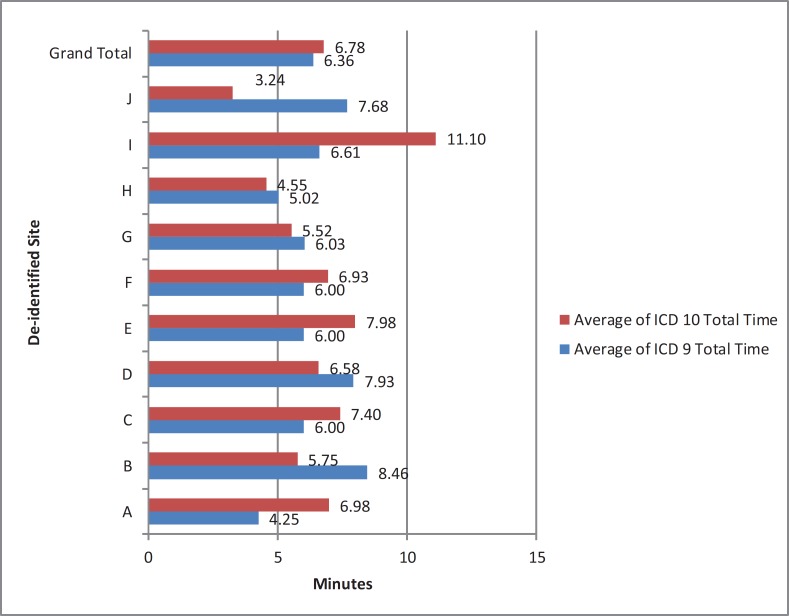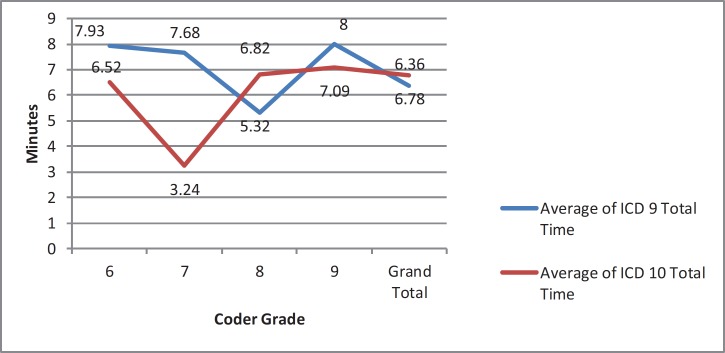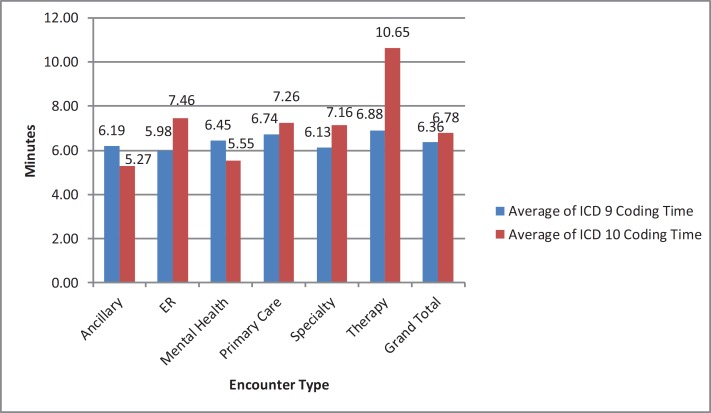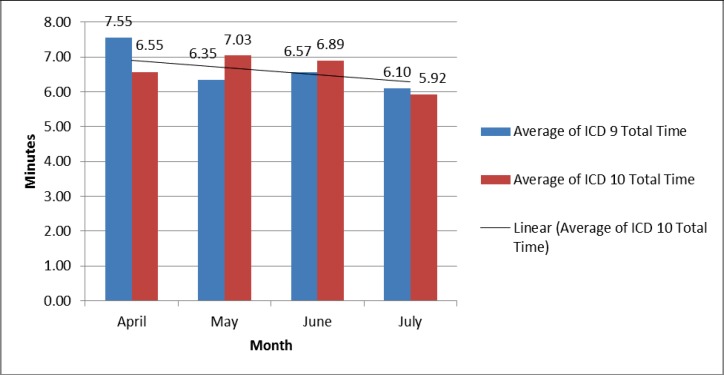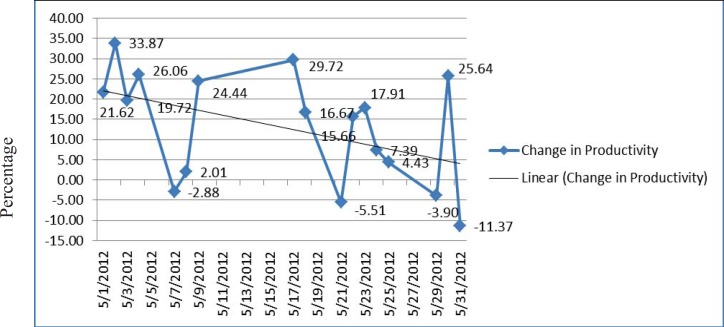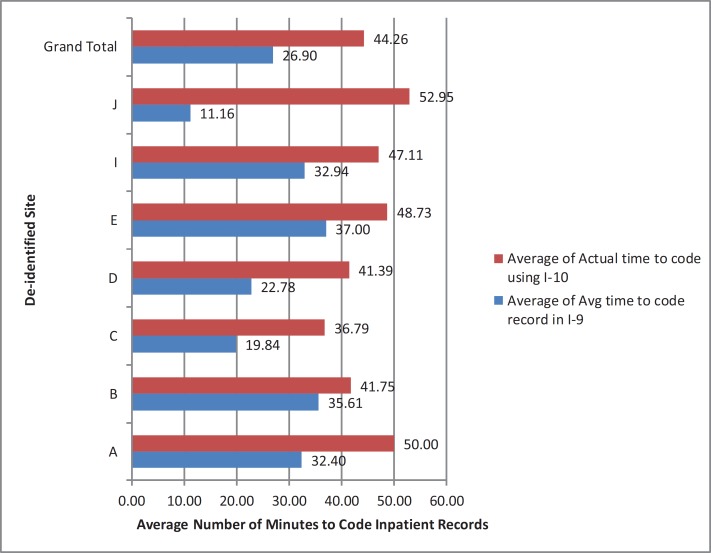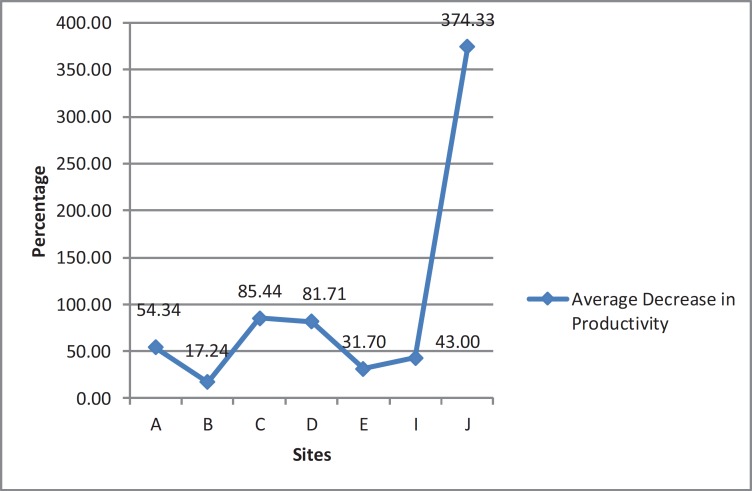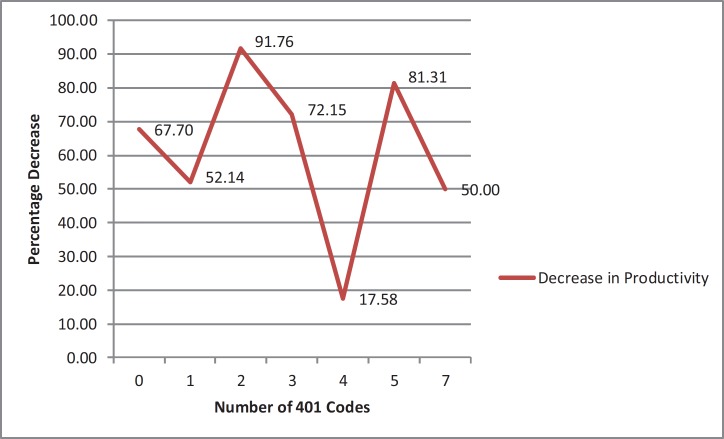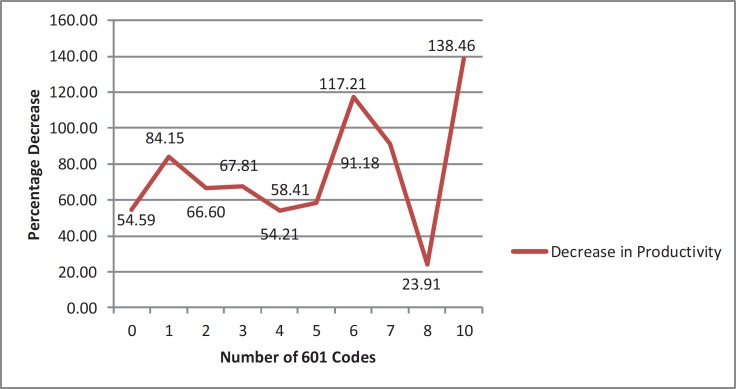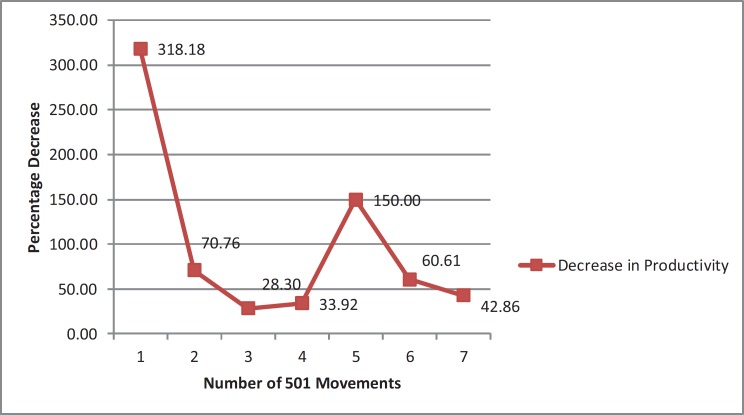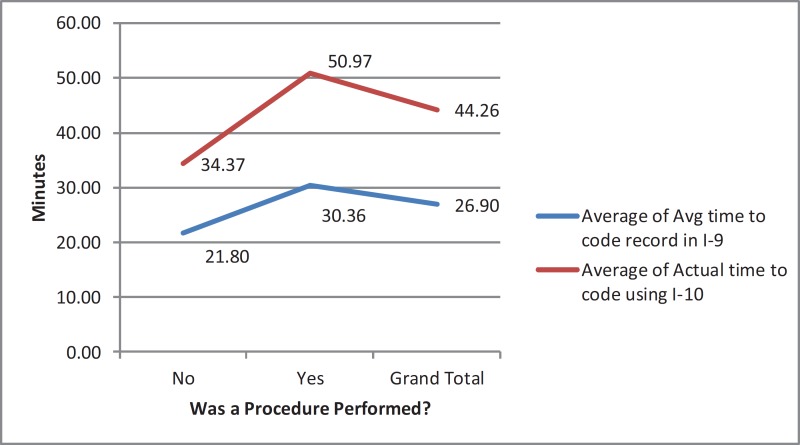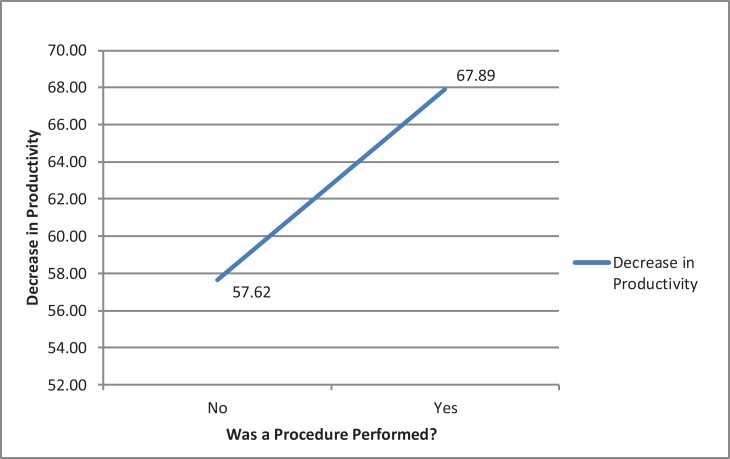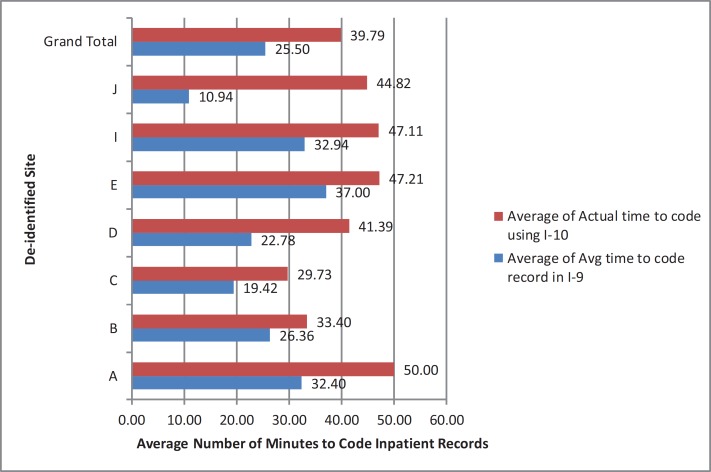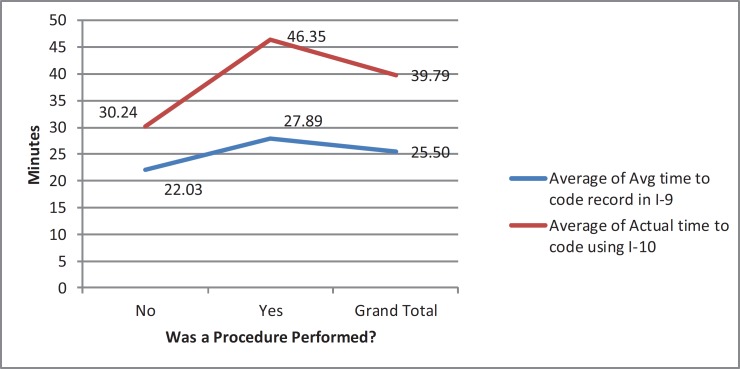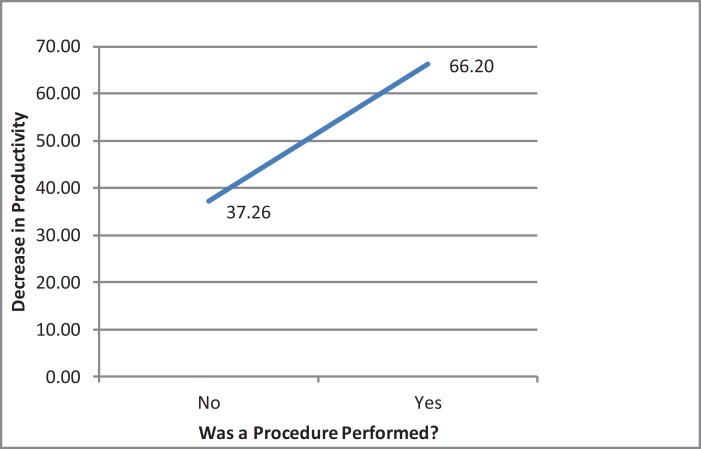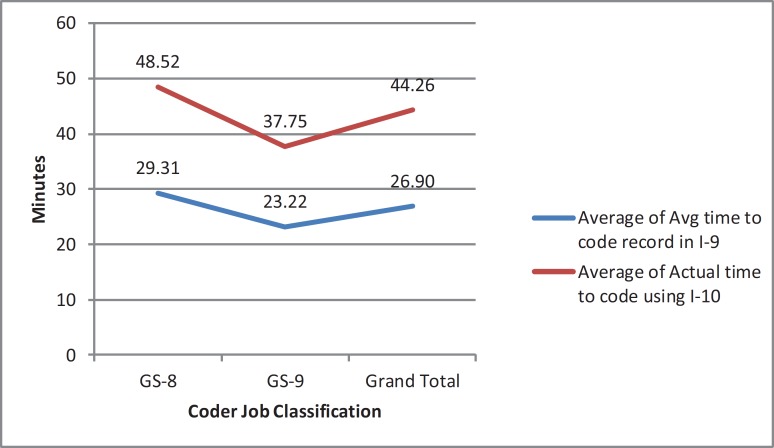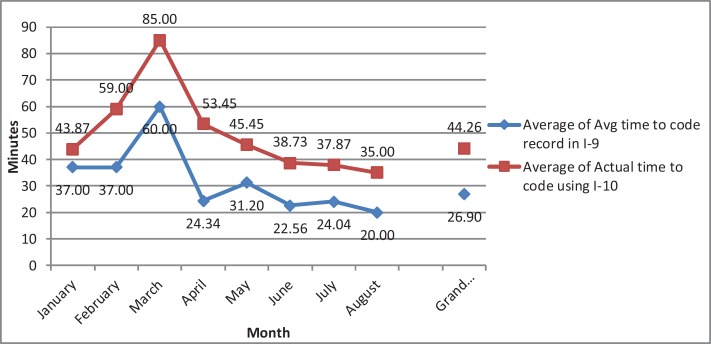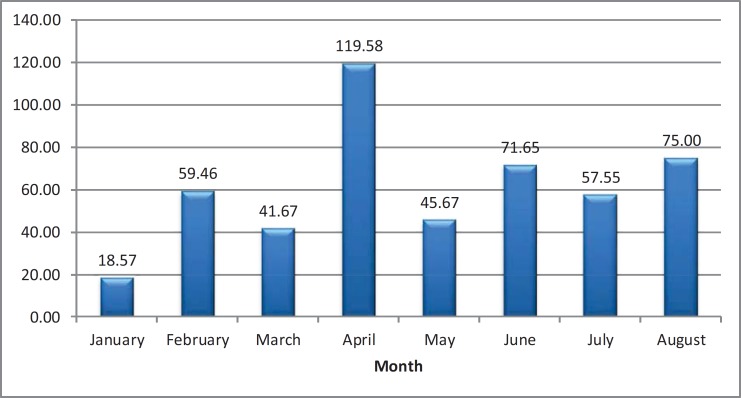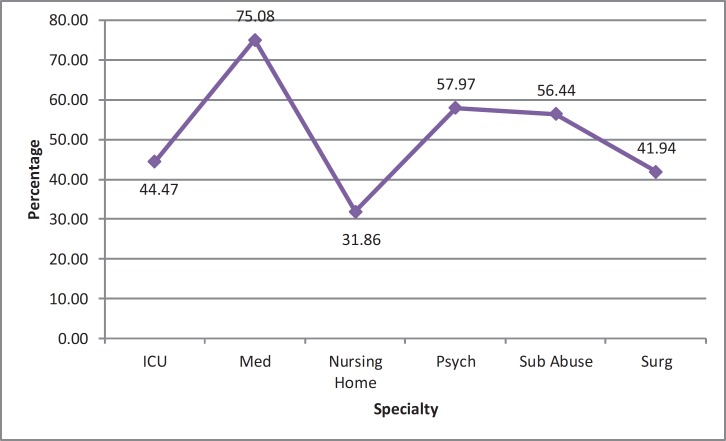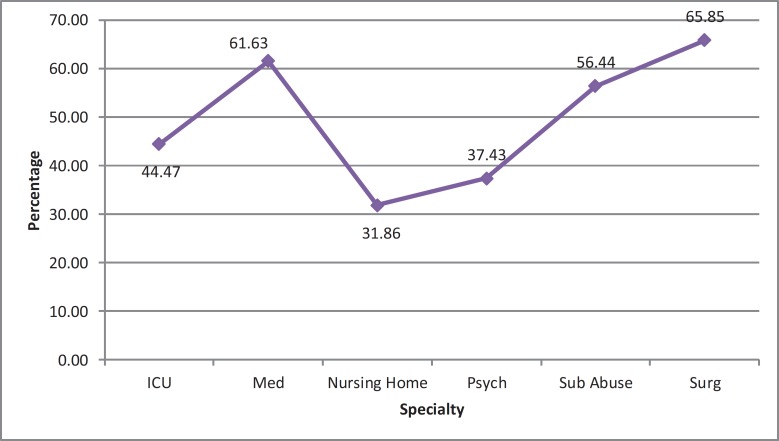Abstract
The Veterans Health Administration (VHA) of the US Department of Veterans Affairs has been preparing for the October 1, 2015, conversion to the International Classification of Diseases, Tenth Revision, Clinical Modification and Procedural Coding System (ICD-10-CM/PCS) for more than four years. The VHA's Office of Informatics and Analytics ICD-10 Program Management Office established an ICD-10 Learning Lab to explore expected operational challenges. This study was conducted to determine the effects of the classification system conversion on coding productivity. ICD codes are integral to VHA business processes and are used for purposes such as clinical studies, performance measurement, workload capture, cost determination, Veterans Equitable Resource Allocation (VERA) determination, morbidity and mortality classification, indexing of hospital records by disease and operations, data storage and retrieval, research purposes, and reimbursement. The data collection for this study occurred in multiple VHA sites across several months using standardized methods.
It is commonly accepted that coding productivity will decrease with the implementation of ICD-10-CM/PCS. The findings of this study suggest that the decrease will be more significant for inpatient coding productivity (64.5 percent productivity decrease) than for ambulatory care coding productivity (6.7 percent productivity decrease).
This study reveals the following important points regarding ICD-10-CM/PCS coding productivity:
Ambulatory care ICD-10-CM coding productivity is not expected to decrease as significantly as inpatient ICD-10-CM/PCS coding productivity.
Coder training and type of record (inpatient versus outpatient) affect coding productivity.
Inpatient coding productivity is decreased when a procedure requiring ICD-10-PCS coding is present.
It is highly recommended that organizations perform their own analyses to determine the effects of ICD-10-CM/PCS implementation on coding productivity.
Keywords: ICD-10-CM/PCS, coder productivity
Introduction
The Veterans Health Administration (VHA) has been preparing for the October 1, 2015, conversion to the International Classification of Diseases, Tenth Revision, Clinical Modification and Procedural Coding System (ICD-10-CM/PCS) for more than four years. Even with this lead time, as the largest healthcare system in the United States, with approximately 108,000,000 ambulatory care encounters and approximately 8,000,000 discharges for both acute and extended care annually, the VHA has had to work hard to prepare for the change. The implementation of the new classification system is expected to affect approximately 80 percent, or 262,000, of the VHA workforce in some fashion.
Background
On January 16, 2009, the US Department of Health and Human Services (HHS) published a Final Rule updating the Health Insurance Portability and Accountability Act (HIPAA) of 1996, enacted as Public Law 104-191, for all covered entities by adopting new inpatient and ambulatory care ICD-10-CM and ICD-10-PCS code sets for encounter dates on or after October 1, 2013.1 On August 24, 2012, HHS delayed the implementation date to October 1, 2014.2 Then, on April 1, 2014, Congress included another delay to October 1, 2015, as a part of a larger Medicare funding bill.3
The new ICD-10-CM/PCS code sets replace the International Classification of Diseases, Ninth Revision, Clinical Modification (ICD-9-CM) and require significant changes in information technology systems, secondary data stores, reporting and analytics systems, problem lists, clinical reminders, encounter forms, screen displays, and printed documents. The implementation of ICD-10-CM/PCS will affect VHA staff at all levels of the organization.
The VHA utilizes ICD codes for purposes such as clinical studies, performance measurement, workload capture, cost determination, Veterans Equitable Resource Allocation (VERA) determination, morbidity and mortality classification, indexing of hospital records by disease and operations, data storage and retrieval, research purposes, and reimbursement. ICD codes form an integral part of the VHA's business process. ICD-10-CM/PCS consists of an expanded listing of diagnosis and procedure codes, representing an increase in the volume of codes from an estimated 20,000 ICD-9-CM codes to a combined 142,000 ICD-10-CM/PCS codes. The increased codes will help research and quality groups to better evaluate and measure medical processes and outcomes. This initiative requires broad support from the VHA's national program offices to serve as business subject matter experts and a robust plan for the enterprise-wide implementation and training of technical users and end users.
Methods
The VHA's ICD-10 Program Management Office established an ICD-10 Learning Lab to explore expected operational challenges. This study was conducted in an attempt to determine the effects of the classification system conversion on coding productivity. The Learning Lab study took approximately seven months, from January through July 2012. Expert ICD-9-CM coders who had received training in ICD-10-CM/PCS were recruited to code records for this study. Upon approval of the proposed study, volunteer pilot sites were recruited and funding was secured for the necessary ICD-10-CM/PCS classification system training, as well as the information technology tools necessary to conduct the study and collect the data.
Each pilot site, consisting of either a Veterans Integrated Service Network (VISN) or a VA medical center, took the following steps:
Appointed a Learning Lab study coordinator to ensure that data were collected in a consistent and timely manner and to resolve issues that arose during the course of the study.
Determined the number of coders per site to participate in the study.
Provided specific demographics for each coder participant, including the following:
○ Grade (a function of experience and education similar to pay scale)
○ Current productivity
○ Specialty (inpatient or ambulatory care)
○ Site
○ Coder or supervisor
Determined the amount of time per day or week to be dedicated to coding in ICD-10-CM/PCS with the least impact on existing workload.
Maintained a listing of records coded in ICD-10-CM/PCS and ICD-9-CM and the actual data collected for use in coding accuracy reviews after the study.
Met regularly with the ICD-10 Program Management Office staff.
Ensured that records were coded in ICD-10-CM/PCS using documentation in the Computerized Patient Record System (CPRS).
Ensured that the number of ambulatory care records coded in ICD-10-CM/PCS per site totaled 100 to 150 by the end of the project.
Ensured that the number of inpatient records coded in ICD-10-CM/PCS per site totaled 50 by the end of the project.
Ambulatory Care Records
A variety of specialty ambulatory care encounters were included in the study. Coder participants dedicated one hour per day to coding ambulatory care encounters in ICD-10-CM using the following criteria:
The average productivity per coder participant was calculated on the basis of the previous month's workload and was used as a baseline to determine ICD-9-CM productivity per hour.
A workload report from the previous month was generated for each coder participant and coded in ICD-10-CM using the CPRS.
The average productivity per coder participant was calculated for ICD-10-CM on the basis of the total number of encounters coded within the hour.
The coder entered patient-specific data including clinic location, ICD-10-CM codes, Current Procedural Terminology (CPT) codes, coder case comments, and documentation issues into a coding worksheet for each encounter coded within one hour.
Patient-specific data collected on the worksheets were maintained by the VISN/site coordinator for use at the end of the study for data comparability reviews.
Once per week, sanitized data from these worksheets were uploaded into the SharePoint data collection tool. These data included the following:
○ Clinic location
○ Number of ICD-9-CM codes assigned
○ Average time spent using ICD-9-CM codes
○ Number of ICD-10-CM codes assigned
○ Average time spent assigning ICD-10-CM codes
○ Indication of whether the ICD-10-CM simulator or coding books were used
○ Any documentation issues found
The data collected did not include patient identifiers or information that could be used to identify the coders. The data collected for the ambulatory care ICD-10-CM coding did not include any assignment of CPT codes. The time logged for ICD-10-CM coding also included the time to record the data in the Microsoft Excel spreadsheet, which was intended to counterbalance the time normally spent assigning CPT codes.
Inpatient Records
Inpatient records for all treating specialty types were included in the study. No inpatient professional fees were coded and recorded. Productivity affected by the recording of professional diagnosis and service codes was balanced by the administrative time recording details for each record in the study. Each participant site determined the specified block of time per week dedicated to coding inpatient records in ICD-10-CM/PCS using the following criteria:
The average productivity per coder participant was calculated on the basis of the previous month's workload report.
The average productivity per coder participant was calculated for ICD-10-CM/PCS on the basis of the total number of inpatient records coded within the specified time frame.
The coder entered patient-specific data including treating specialty, ICD-10-CM/PCS codes for each Patient Treatment File (PTF) segment including each “501” movement (transfer between units), documentation issues, reasons for physician queries, and references used into a coding worksheet for each inpatient record coded within the specified time frame.
Patient-specific data collected on these worksheets were maintained by the VISN/site coordinator for use at the end of the study for data comparability reviews.
Once per week, sanitized data from these worksheets were uploaded into the SharePoint data collection tool. These data included the following:
○ Treating specialty
○ Number of ICD-9-CM codes assigned per PTF segment
○ Average time spent assigning ICD-9-CM codes
○ Number of ICD-10-CM/PCS codes assigned per PTF segment
○ Average time spent assigning ICD-10-CM/PCS codes
○ An indication of whether the ICD-10-CM/PCS simulator or coding books were used
○ Any documentation issues
The data collected did not include patient identifiers or information that could be used to identify the coders.
Data Analysis
The analysis of the ambulatory care and inpatient data was conducted using Microsoft Excel with the pivot table function. The formula for determining the percentage increase or decrease in productivity was (((Average ICD-10 Coding Time – Average ICD-9 Coding Time) / Average ICD-9 Coding Time) * 100). The t-test was used to determine whether the differences in the average coding times were statistically significant.
Results
Ambulatory Care
Overall Averages
A total of 1,024 ambulatory care records were coded. The 10 coders reported numbers of records coded ranging from 1 to 423. The 11 participating sites reported numbers of records coded ranging from 25 to 211. The total average time to code ambulatory care records in ICD-9-CM was 6.36 minutes. The total average time to code ambulatory care records in ICD-10-CM was 6.78 minutes. This is an overall decrease in productivity of 6.7 percent. A t-test comparing the means between the two samples was statistically significant with a p-value less than .001. Figure 1 shows the results for each site.
Figure 1.
Average Ambulatory Care Coding Time by Site
Legend Note: ICD 10 refers to ICD-10-CM/PCS. ICD 9 refers to ICD-9-CM.
Coder Grade
The data were evaluated to determine any differences in average time to code in ICD-9-CM and ICD-10-CM based on coder demographics. Figure 2 details the average time to code by coder grade, indicating that the level of experience and formal training as typically outlined by job grade is a factor in the impact on productivity in the ICD-10-CM/PCS transition. The lower-graded coders coded ICD-10-CM records on average in less time than coders with more experience or credentials as indicated by higher coder grade.
Figure 2.
Average Ambulatory Care Coding Time by Coder Grade
Legend Note: ICD 10 refers to ICD-10-CM/PCS. ICD 9 refers to ICD-9-CM.
By Encounter Type
Ambulatory encounters were categorized into the following types for purposes of data aggregation: Ancillary (x-ray, lab, etc.); Emergency Room, including urgent care; Mental Health; Primary Care; Specialty Clinics, such as dermatology, podiatry, and so forth; and Therapy (physical therapy, kinesiotherapy, and occupational therapy). The average ICD-9-CM and ICD-10-CM coding times by encounter type are outlined in Figure 3. The largest change in productivity occurred in the Therapy type of ambulatory encounter, which included physical therapy, kinesiotherapy, and occupational therapy; this type was followed by the Emergency Room encounter type, including urgent care. The change in productivity for the therapy encounter types are likely due to a change in the coding conventions used for post-acute care and physical therapy. The change in productivity for the Emergency Room care category is likely due to the variability of diagnoses encountered in the Emergency Room and potential changes to coding conventions across the code set.
Figure 3.
Average Ambulatory Care Coding Time by Encounter Type
Legend Note: ICD 10 refers to ICD-10-CM/PCS. ICD 9 refers to ICD-9-CM.
Month
To determine the potential rate of recovery for coder productivity, the data were evaluated over the time of the study. The results in Figure 4 appear to indicate that the average coding time in ICD-10-CM/PCS improved as coders became more experienced. A limitation of this analysis was that site participation time frames did not all overlap. As a result, the ambulatory care records were evaluated in the month of May (see Figure 5) to ensure that all sites were actively participating. The improvement in coding productivity is even more pronounced.
Figure 4.
Average Coding Time by Month
Legend Note: ICD 10 refers to ICD-10-CM/PCS. ICD 9 refers to ICD-9-CM. Linear is the plot of line of the Average ICD-10-CM/PCS Coding time per month.
Figure 5.
Change in Coder Productivity between ICD-9-CM and ICD-10-CM/PCS for May 2012
After this thorough examination of the ambulatory care coding productivity data, attention was turned to the inpatient coding productivity data.
Inpatient
Overall Averages
A total of 317 inpatient records were coded in ICD-10-CM/PCS by a total of 13 coders across seven sites. The total average time to code the inpatient records in ICD-9-CM was 26.90 minutes. The total average time to code the inpatient records in ICD-10-CM/PCS was 44.26 minutes. This is an overall decrease in productivity of 64.5 percent. A t-test comparing the means between the two samples was highly statistically significant with a p-value less than .001. Figure 6 shows the average number of minutes to code in each classification system at each site. As shown in the figure, each site reported a longer coding time in ICD-10-CM/PCS than in ICD-9-CM. Figure 7 shows the decrease in productivity by site.
Figure 6.
Average Inpatient Coding Time to Code in ICD-9-CM and ICD-10-CM/PCS by Site
Sites F, G, and H did not code inpatient records and are excluded.
Legend Note: ICD 10 refers to ICD-10-CM/PCS. ICD 9 refers to ICD-9-CM.
Figure 7.
Average Decrease in Inpatient Coding Productivity by Site
Sites F, G, and H did not code inpatient records and are excluded.
Figure 8 illustrates the average decrease in productivity by number of 401 (procedure) codes. Figure 9 reveals the decrease in productivity by number of 601 codes (major surgery). Figure 10 reveals that the four records with one transfer (501 movement) had the largest decrease in productivity; these records correspond to those records whose productivity decreases were shown to be outliers with greater than 200 minutes per record for coding time. Records with more than one interfacility treating specialty bed movement (501 movement), which account for a larger number of records in the sample, show lower decreases in productivity.
Figure 8.
Decrease in Inpatient Coding Productivity by Number of 401 (Procedure) Codes
Figure 9.
Decrease in Inpatient Coding Productivity by Number of 601 (Major Surgery) Codes
Figure 10.
Decrease in Inpatient Coding Productivity by Number of 501 Movements (Interfacility Transfers)
By Presence of Procedures
The substantial changes between ICD-9-CM and ICD-10-PCS triggered a separate examination of the impact on records with inpatient procedures. It was hypothesized that coding using ICD-10-PCS for procedures would take longer on average than coding using only ICD-10-CM. As shown in Figure 11, the presence of one of more procedures does increase the time to code a record both with ICD-9-CM and with ICD-10-CM/PCS. Figure 12 reveals that the decrease in productivity when coding with ICD-10-CM/PCS was 10 percent greater when a procedure was performed.
Figure 11.
Average Inpatient Coding Time by Procedure Presence
Legend Note: ICD 10 refers to ICD-10-CM/PCS. ICD 9 refers to ICD-9-CM.
Figure 12.
Percentage Decrease in Inpatient Coding Productivity by Procedure Presence
Outliers
Noting the wide variance in coding times between sites and individual records, the team determined that there were multiple records for which the coding time exceeded 100 minutes, or more than 1.5 hours. The team decided to examine the impact of these outlier records on the results. Overall, without the outlier records the average inpatient time to code a record was 25.5 minutes. The average time to code in ICD-10-CM/PCS was 39.79 minutes, an average decrease in productivity of 56.03 percent. Figure 13 shows the average time to code in both ICD-9-CM and ICD-10-CM/PCS by site without the outliers. When compared with the results shown in Figure 6, the time to code in ICD-10-CM/PCS for site J dropped by more than eight minutes from 52.95 to 44.82.
Figure 13.
Average Inpatient Coding Time in ICD-9-CM and ICD-10-CM/PCS by Site, without Outliers
Sites F, G, and H did not code inpatient records and are excluded.
Legend Note: ICD 10 refers to ICD-10-CM/PCS. ICD 9 refers to ICD-9-CM.
When examined without the outliers, the difference in coding time for records with procedures becomes much more marked, as shown in Figure 14 and Figure 15. As shown in Figure 15, the decrease in coding productivity when a procedure was performed was 29 percent greater than when a procedure was not performed.
Figure 14.
Average Inpatient Coding Time by Procedure Presence, without Outliers
Legend Note: ICD 10 refers to ICD-10-CM/PCS. ICD 9 refers to ICD-9-CM.
Figure 15.
Percentage Decrease in Coding Productivity by Procedure Presence, without Outliers
Coder Grade
The data were also analyzed to determine whether there were any differences in average time to code in ICD-9-CM and ICD-10-CM/PCS by coder demographics, for example, job grade. Ten General Schedule (GS)-8 coders and three GS-9 coders participated in the inpatient study. Figure 16 demonstrates a consistent relationship between coder grade and productivity.
Figure 16.
Average Inpatient Coding Time by Coder Grade
Legend Note: ICD 10 refers to ICD-10-CM/PCS. ICD 9 refers to ICD-9-CM.
By Month
Productivity recovery was evaluated by analyzing the data over time. The results in Figure 17 indicate that the average coding time in ICD-10-CM/PCS improved over time. However, they also show a corresponding decrease in average ICD-9-CM coding time. An explanation for this decrease in productivity is unknown. Figure 18 shows the percentage decrease in productivity by month.
Figure 17.
Average Inpatient Coding Time by Month
Legend Note: ICD 10 refers to ICD-10-CM/PCS. ICD 9 refers to ICD-9-CM.
Figure 18.
Decrease in Inpatient Coding Productivity by Month
By Specialty
Inpatient records were further divided by specialty for purposes of data aggregation. Figure 19 shows the average decrease in coder productivity by specialty. The greatest variability in coding productivity for ICD-10-CM/PCS was found for acute medical hospital records. The same analysis also was conducted without the extended coding time outliers, and those results can be seen in Figure 20.
Figure 19.
Decrease in Inpatient Coding Productivity by Specialty
Figure 20.
Decrease in Inpatient Coding Productivity by Specialty, without Outliers
Discussion
Overall coding productivity will decrease with the implementation of ICD-10-CM/PCS on October 1, 2015. The impact on coder productivity is greater for inpatient records (64.5 percent productivity decrease) than for ambulatory care records (6.7 percent productivity decrease). Several factors may be responsible for this impact, according to subject-matter experts involved in the ICD-10 transition and the Learning Lab. The first factor is that the ICD-10 inpatient coding time includes the use of ICD-10-PCS, the procedural coding system. ICD-10-PCS is enormously different than ICD-9-CM, volume 3—the current inpatient procedural coding system—in the number of codes, format, conventions, guidelines, and methodology for determining the correct code value. Procedural coding for ambulatory care will not change from the CPT-4 system. The second factor resulting in an overall decrease in productivity is the change in coding conventions and guidelines. Another factor identified during this Learning Lab study is that the ambulatory care record type resulted in variation in coding time based on the availability, quality, and consistency of documentation. Inpatient records may not contain all of the documentation needed to fully code the stay; however, the VA electronic health record usually offers more consistency in the type of documentation and location of the inpatient documents. A given ambulatory care encounter may be very specialized and thus different encounters will have different types of document, whereas an inpatient stay will have standard core documentation. This factor is supported by Figure 3, which demonstrates that in the Ancillary Clinic category the average ICD-10-CM coding time was less than the average ICD-9-CM coding time. In general, the process used for assigning ambulatory care diagnostic codes in ICD-10-CM is the same process used in ICD-9-CM; thus, the only factor for inclusion in the expected loss of productivity is changes in the coding conventions and guidelines. The participants in the Learning Lab felt that these impacts could be minimized or overcome by training on coding conventions and guidelines early and continued dedicated time spent coding records in ICD-10 until the actual transition date. Overall, the availability of reference sources for guidance, such as the Coding Clinic published by the American Hospital Association, which coders heavily rely on for ICD coding guidance, contributed to an increase in the time needed, particularly in cases where questions based on ICD-10-CM/PCS coding conventions and guidelines arose. At the time of this study, very few ICD-10-CM/PCS reference materials were available; therefore, researching specific guidance for any questions required more time than would have been needed for research with ICD-9-CM.
In this study, several unplanned results were realized. Coders who lacked experience and confidence at the beginning of the study gained more knowledge and confidence by the end. The study combined basic upfront training on differences between the two code sets with a “learn as you go” approach for coding actual cases, which was well received by the coding participants and provided some reassurance of coding ability using ICD-10-CM/PCS. In some cases, researching specific categories or chapters was beneficial to ensure coding accuracy based on ICD-10-CM/PCS as opposed to ICD-9-CM. The coding of records using ICD-10-CM/PCS allowed the coders to gain practical experience using the new code set. This experience reduced anxiety and fostered excitement about the transition among coders who participated in the study and those co-workers not participating. The practical experience and dedicated coding time for ICD-10-CM/PCS encouraged group discussion among coders and coding supervisors on coding guidelines to include differences between ICD-9-CM and ICD-10-CM/PCS. These discussions led to increased understanding of coding conventions and guidelines, utilizing knowledge and skills from all coders to affect education and training for all coding staff. The coding supervisors found improvements in the coding accuracy for ICD-9-CM coding as a result of what they perceived as getting back to coding basics through reinforcement of coding conventions and guidelines. The study promoted attention to detail in a learning environment and allowed site participants to identify documentation issues based on provider documentation habits and encounter types within their individual facilities. This factor was perceived as an advantage for field sites by allowing them to customize their focus for education and training based on individual needs in preparation for the ICD-10-CM/PCS transition. It was determined that this customization would minimize overall training time by eliminating unnecessary training for stakeholders that would otherwise be needed when considering the entire organization.
Ambulatory Care
The specialty type of encounter did impact ICD-10-CM coding time and, consequently, coding productivity. Most notably, the decrease in coding productivity for therapy encounters was 54.7 percent. This change was more than double the decrease for the other encounter types in which a decrease in coding productivity was found. This decrease was likely related to the change in coding guidelines for encounters for therapy and significant changes in conventions in ICD-10-CM related to follow-up and treatment of sequelae.
The difference in coding productivity by coder demographics was examined. The coder grade/experience level and encounter specialty type were not shown to have a significant impact in the comparison of ICD-9-CM coding productivity and ICD-10-CM coding productivity.
Inpatient
Inpatient coder productivity results showed a larger impact in coder productivity than was found in ambulatory care, with significant variance noted between sites. The decrease in coding productivity ranged from 17.24 percent to 374.33 percent. Detailed analyses of coding productivity by number of records containing procedure (401) and surgical (601) codes, as well as by number of interfacility treating specialty bed transfers (501 movements) indicated no clearly discernible trends, as outlined in Figure 8, Figure 9, and Figure 10. Data analysis indicated that the results were not related to the number of records coded but suggested that the results can be attributed to two primary reasons: (1) documentation and changes in coding conventions and (2) new methodologies for ICD-10-CM/PCS code determination that must be accurately applied.
A review of the time to code inpatient records in ICD-10-CM/PCS revealed a range of 369 minutes, with a minimum of 9 minutes and a maximum of 378 minutes. The mean was 44.26 minutes, and the mode was 60 minutes. An examination of all records requiring more than 100 minutes to code in ICD-10-CM/PCS revealed documentation challenges related to minor procedures such as blood transfusion, mechanical ventilation, echocardiogram, and so forth, which presented challenges for coding staff in terms of the availability of documentation needed to code. Although the differences between ICD-9-CM, volume 3, and ICD-10-PCS have been the subject of much discussion, this study revealed that documentation gaps for minor procedures may likely be challenging because these procedures are not documented in a single known document type and with the same level of detail as compared to operating room procedures, which result in an operative note.
Conclusions
Although coder productivity is expected to decrease, a focus on the means to minimize this decrease and an emphasis on continued coding accuracy at current standards may actually result in an insignificant or no actual impact. In order for facilities to minimize impacts and adequately prepare staff, dedicated training time must be allowed on a regular recurring basis, for example, two to six hours per week depending on record type and current workload, to perform activities such as the recoding of records using ICD-10-CM/PCS as outlined in this study. Other factors that may need careful review and consideration are monthly and annual data reporting periods for data collection snapshots, as well as the impact on coder productivity of other responsibilities such as education and documentation improvement initiatives.
This study revealed the following important points regarding ICD-10-CM/PCS coding productivity. Individual facilities can utilize training time with adequate allowances for coders to prepare using actual records to practice ICD-10-CM/PCS coding, which will likely minimize productivity decrease and identify early other improvement opportunities, such as documentation quality, to minimize the impact of ICD-10-CM/PCS implementation. Information gained from a process similar to this Learning Lab study, allowing coders to recode records within a specific time frame using ICD-10-CM/PCS coding conventions and guidelines, can help facilities identify documentation improvement initiatives that need specific focus and determine allowances needed in all areas. Important points identified from the study include the following:
Ambulatory care ICD-10-CM coding productivity is not expected to decrease as significantly as inpatient ICD-10-CM/PCS coding productivity.
Inpatient coding productivity is expected to decrease greatly, but can be minimized through preparation prior to the compliance deadline. The coder training and type of encounter will likely have a significant effect on the coding productivity; starting early with an allowance for coding records in ICD-10-CM/PCS may minimize this impact.
Clinical documentation improvement initiatives can minimize risk by addressing and resolving documentation requirements for procedures.
Establish criteria related to physician queries and research of coding questions during the coding process to minimize the amount of time coders should spend on any given record. These criteria will ensure that coding productivity decreases are minimized.
Overall, this study provides important information for all healthcare provider organizations preparing for ICD-10-CM/PCS implementation. It is highly recommended that all organizations perform their own analyses to determine the effects of ICD-10-CM/PCS implementation on coding productivity. The benefits that can be gained, in addition to minimized risk of decreased coder productivity, are improved coder accuracy in ICD-9-CM coded records, improved documentation quality, and overall reduction in anxiety related to the transition. Organizations should also consider making allowances in the performance standards of coding staff beginning with implementation and continuing through any recovery period, which is not expected to exceed six months.
Contributor Information
Shelley Weems, Shelley Weems, RHIA, CCS, is a health information management specialist in the Veterans Health Administration Office of Informatics and Analytics in Washington, DC..
Pamela Heller, Pamela Heller, RHIA, CCS-P, is the director of health information management in the Veterans Health Administration Office of Informatics and Analytics in Washington, DC..
Susan H. Fenton, Susan H. Fenton, PhD, RHIA, FAHIMA, is a program specialist in the Veterans Health Administration Office of Informatics and Analytics in Washington, DC..
Notes
- 1.Department of Health and Human Services. “HIPAA Administrative Simplification: Modifications to Medical Data Code Set Standards to Adopt ICD-10-CM and ICD-10-PCS.” 45 CFR Part 162. Federal Register. January 16, 2009;74(11):3328–62. Available at http://edocket.access.gpo.gov/2009/pdf/E9-743.pdf. [PubMed] [Google Scholar]
- 2.Department of Health and Human Services. “Administrative Simplification: Adoption of a Standard for a Unique Health Plan Identifier; Addition to the National Provider Identifier Requirements; and a Change to the Compliance Date for the International Classification of Diseases, 10th Edition (ICD–10–CM and ICD–10–PCS) Medical Data Code Sets.” 45 CFR Part 162. Federal Register. September 5, 2012;77(172):54664. [PubMed] [Google Scholar]
- 3.Protecting Access to Medicare Act of 2014. U.S. Congress. Public Law 113-93. April 1, 2014.



